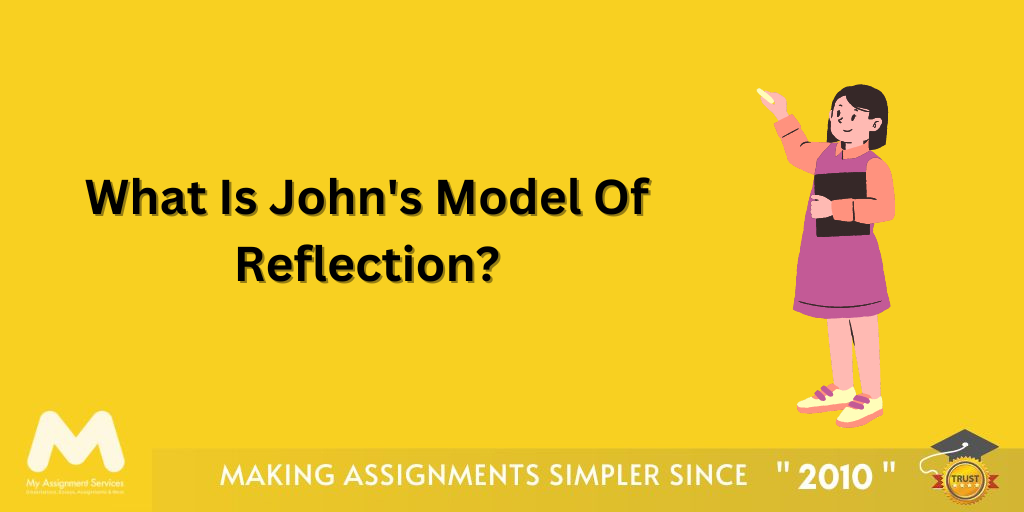
Johns model of reflection has been a pioneer in developing new ideas and frameworks for effective learning. It is widely used by different professionals from all sorts of disciplines. The framework of reflection theorised by Johns has been an exemplary framework for bringing productivity and growth. The very fabric for the idea of reflection by Johns has come from someone else. The model of reflection suggests that there should be a connection between your experience and outcomes.
What constitutes the thought process behind the Johns structured model of reflection is two-way reflection. One is inward reflection, and the other is outward reflection. What does both of these mean? How did Johns conceptualise the idea of the model of structured reflection? From where did this come in, and why is it significant? What kind of insight do they provide, and what do those insights mean? We will cover and uncover all these questions and their answers. You will learn about Johns' model of reflection in an in-depth discussion.

The Johns model of reflection is a structured framework to define how one should analyse their actions better in relation to a previous experience. The reflection of the individual goes two ways in this framework - inward and outward. Inward reflection means the consideration of one's own actions and analysing them. It helps an individual understand better about themselves in that particular context. On the other hand, outward reflection is the identification of other people's involvement in a particular situation. It proposes a series of questions, forming a structure.
Johns structured model of reflection or Johns model of structured reflection (MSR) was introduced by Christopher Johns. He was a nurse educator (professor) and a practitioner who came up with this model in 1994. Originally published in the early 90s, the idea was inspired by another important figure in the nursing profession - Dr. Barbara Carper. Dr. Barbara A. Carper was also a nursing professor who introduced "Fundamental Patterns Of Knowing In Nursing". Her work was published in 1978 at the College of Nursing at Texas Woman's University.
Carper's "Fundamental Patterns Of Knowing In Nursing" is similar to Johns model of reflection. Her work focused on a structure that would bring effective learning outcomes in the nursing profession and treat patients better. It is composed of the same crucial aspects (patterns) that we need to reflect on and comprehend. With the comprehension of these patterns, the nurse-patient relationship contributed to better treatment and healthcare provisions. These patterns are the same as Johns but consist of only four, which are:
Johns structured model of reflection came into existence because of the revolutionary shift in nursing due to Carper's work. The basic intent is reflection - something that is done consciously to think of the actions and form opinions about it. The opinions can be both subjective and objective. The basic intent is the same in both, but what Carper's five (not four) patterns form in combination is something that can be interpreted differently. The idea behind both the theory and interpretation is the same. However, Johns's interpretation added one more aspect to this.
Just as an academic writer knows what he or she knows to write in a student's assignments, any professional knows what he or she is doing. This phase informs the idea of explaining any experience and reflecting upon it in a factual manner. This can include statements such as:
The second phase informs us that we need to reflect on our involvement in the experience. It helps us to understand our individual contribution to the experience. This phase of Johns model of reflection allows us to consider our and other people's feelings. We also learn about what influential factors might have contributed to the experience. Examples can be like this:
This phase informs the idea of taking into account what moral values we put into use during the experience. It helps us understand what kind of moral knowledge we possess. This phase of Johns structured model of reflection allows us to learn whether our actions match with the values we have. The questions that can be raised as examples in this are:
This phase informs us about the idea to consider alternative actions and think about our work. If an online assignment expert provided you with their knowledge, that counts as empirical evidence. Here, empirical means the knowledge of your profession and what you know about it. Examples can be like this:
Reflexivity here informs the idea that we have to reflect on what lessons we have learned. In this phase of Johns model of reflection, you think and decide what your course of action should be based on those learnings. It is the original addition done by Christopher Johns in his original work, making the theory of reflection. The exemplary questions can be like this:
Like any other model introduced so far by the pioneers and theorists, Johns structured model of reflection has pros and cons. What does this constitute of? Let us know about both of them.
You have learned about the Johns model of structured reflection. What structure are you planning to present in your assignment? Working on the same topic as Johns model or something similar? Is it about nursing or something else? Don't worry - My Assignment Services have immense options for you. We have a dedicated team of academic experts who help students from different academic disciplines. Take our assignment help online to get started. Register now!

Jacob is an erudite professional who has a strong command of the concepts involved in microeconomics and macroeconomics. Being a reputed economist in Australia for the last seven years, he provides online tutoring sessions to students worldwide. This is due to his love for teaching that he has always been available to cater to queries in different areas within the broad paradigm of economics. For the same reason, he has joined hands with My Assignment Services to provide expert consultation to students who find it challenging to deal with their university assignments.
1,212,718Orders
4.9/5Rating
5,063Experts
Bonanza Offer
Get 40% Off *
on your assignment today
Trending now
The Student Corner
Subscribe to get updates, offers and assignment tips right in your inbox.
Popular Posts
Popular Posts
Doing your Assignment with our samples is simple, take Expert assistance to ensure HD Grades. Here you Go....
Loved reading this Blog? Share your valuable thoughts in the comment section.
Add comment